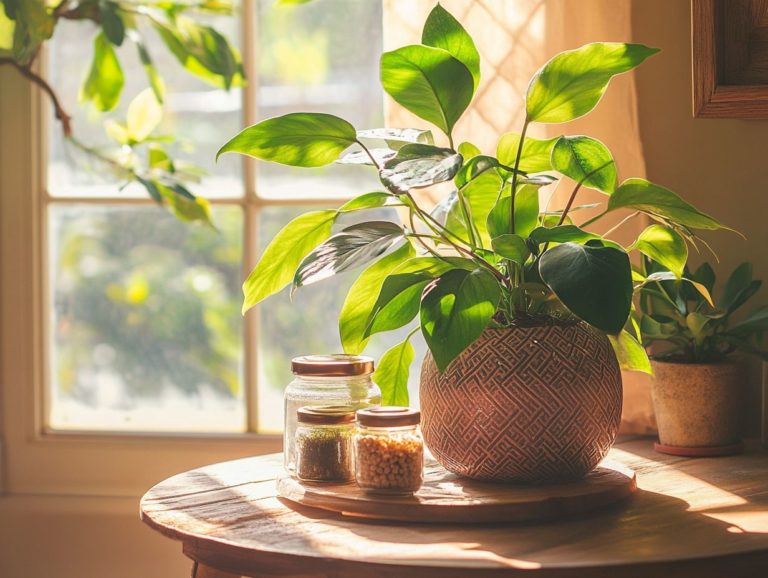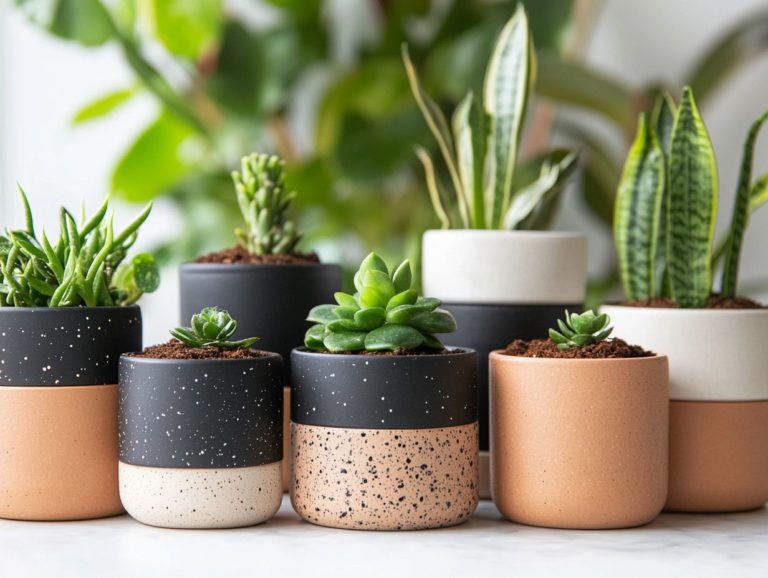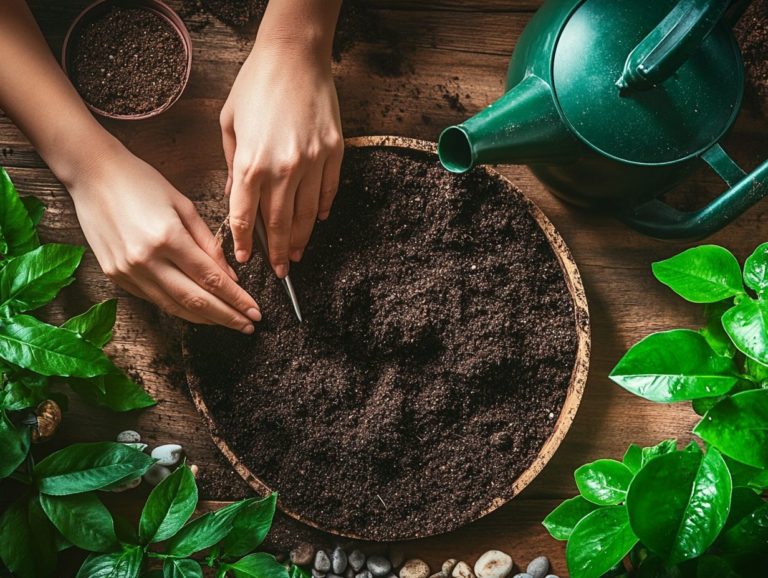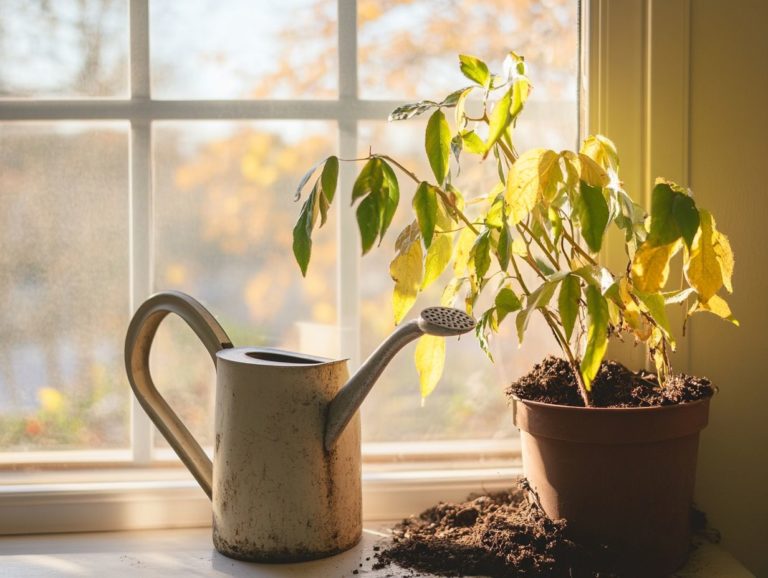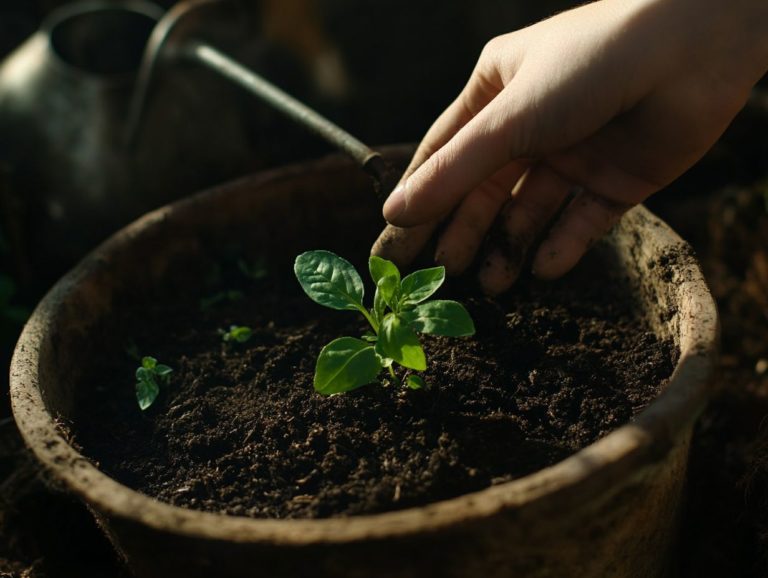Exploring the Different Types of Potting Soil
Selecting the right potting soil can be a game-changer in your gardening journey, whether you’re cultivating radiant orchids or resilient succulents.
With a variety of mixes designed for specific plants, understanding your options is crucial. From blends that hold water well to handcrafted recipes, this guide explores 15 distinct types of potting soil, highlighting their unique benefits and helping you choose the perfect mix for your plants.
Dive in to find the perfect potting mix for your gardening dreams!
Contents
- Key Takeaways:
- 1. All-Purpose Potting Soil
- 2. Cactus and Succulent Potting Mix
- 3. Seed Starting Mix
- 4. Orchid Potting Mix
- 5. African Violet Potting Mix
- 6. Acid-Loving Plant Potting Mix
- 7. Moisture Control Potting Mix
- 8. Raised Bed Potting Mix
- 9. Bonsai Soil Mix
- 10. Terrarium Potting Mix
- 11. Organic Potting Soil
- 12. Peat-Free Potting Mix
- 13. Vermiculite and Perlite Potting Mix
- 14. Soilless Potting Mix
- 15. Homemade Potting Soil Recipes
- What Factors Should Be Considered When Choosing Potting Soil?
- Frequently Asked Questions
Key Takeaways:
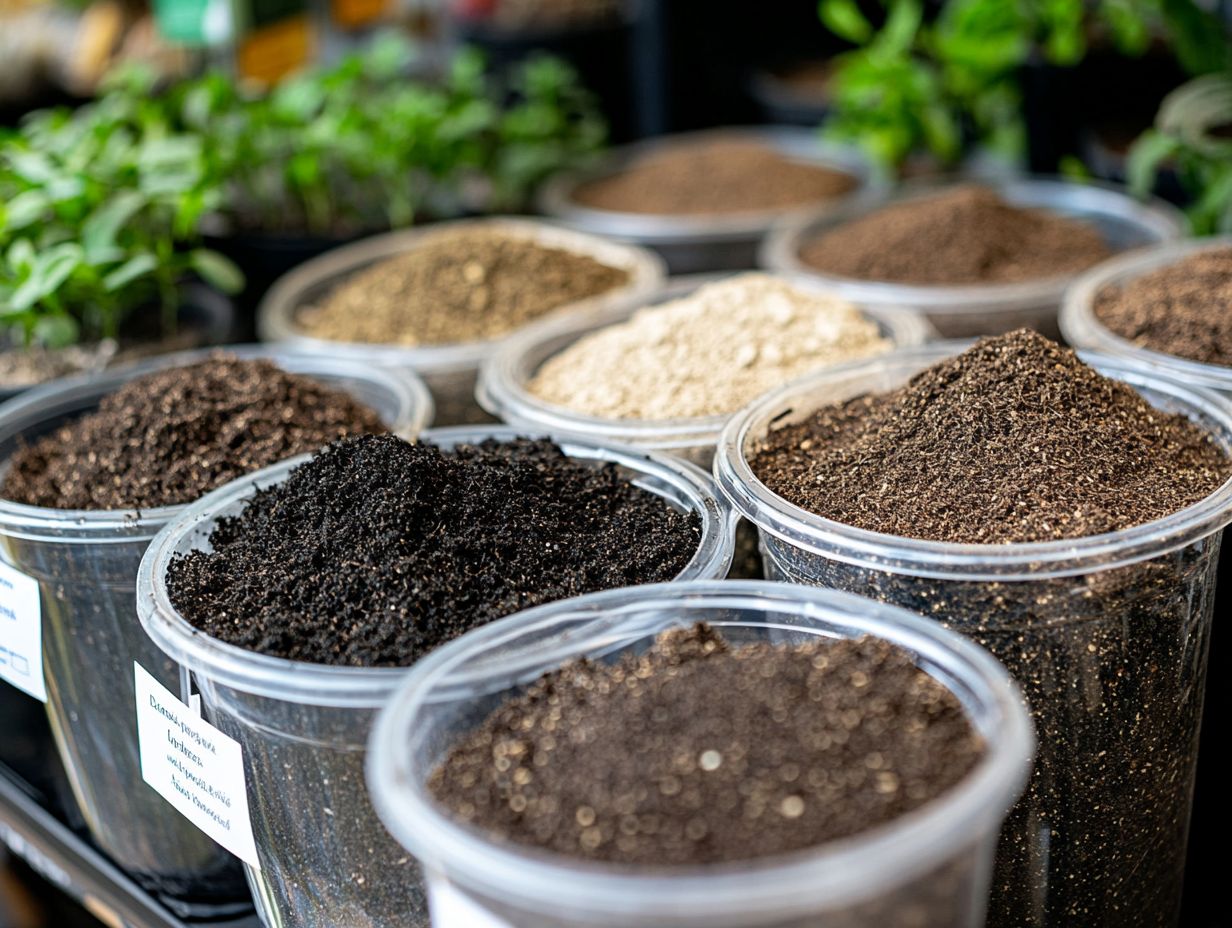
- Choose the right potting soil for your plants each type is formulated for specific needs.
- Organic potting soil, like eco-friendly blends, benefits both plants and the environment, while non-organic options may have higher nutrient levels.
- Create your own potting mix with ingredients like vermiculite, perlite, and peat moss to meet your plants’ unique needs.
1. All-Purpose Potting Soil
All-purpose potting soil is your go-to medium for a diverse range of gardening endeavors, whether you’re nurturing vibrant container plants indoors or cultivating flourishing outdoor gardens. This potting mix is expertly designed to support robust plant growth by balancing water retention and nutrient availability.
It’s crafted to ensure an optimal soil structure for various plants, from cheerful marigolds to lush hydrangeas. With its blend of organic materials, it creates an ideal environment for roots to flourish while delivering important nutrients for plant growth.
Typically, all-purpose potting soil contains peat moss, which helps hold water, allowing your plants to thrive even during dry spells. Perlite is often included to boost aeration and prevent root rot by allowing excess water to drain away. Vermiculite adds to the mix by ensuring that vital nutrients are readily available to your plant roots.
These carefully selected ingredients make this potting soil perfect for different plant types from fragrant herbs to resilient succulents, supporting healthy growth in both indoor and outdoor settings. To ensure you’re using the best products, learn how to buy quality potting soil. Its well-balanced ecosystem fosters vibrant blooms and lush foliage, making it a reliable choice for gardeners eager to cultivate a diverse array of plant species.
2. Cactus and Succulent Potting Mix
Cactus and succulent potting mix is your go-to solution for creating the ideal environment for these resilient plants. It s designed to ensure optimal soil drainage and air circulation, both essential for their healthy growth.
This specialized mix includes:
- Coarse sand, which enhances drainage by allowing water to flow swiftly through, preventing roots from sitting in excess moisture that can lead to rot.
- Perlite, a lightweight volcanic glass that further improves aeration and drainage while keeping the texture light.
- Coco coir, providing moisture retention without oversaturation essential since these plants thrive on a bit of moisture but not in standing water.
Standard potting soil can be dense and overly moisture-retaining, leaving your cacti and succulents wanting for a specific cacti and succulent potting soil. That s why this tailored potting mix is crucial for their thriving health.
Start your gardening journey today choose the right soil mix now!
3. Seed Starting Mix
Seed starting mix is a finely textured potting soil designed to help your seeds germinate and grow. It focuses on holding nutrients and moisture, making sure your seeds thrive from the beginning.
This specialized mix, often called seed starting potting soil, creates the perfect environment for young plants, which have different needs compared to mature plants. Key ingredients like peat moss help maintain moisture, keeping the humidity levels just right for germination. At the same time, vermiculite improves airflow, which helps prevent root rot.
Young plants need plenty of light and specific temperatures to grow well. A quality seed starting mix provides the ideal foundation. It ensures your seedlings get the right mix of moisture and nutrients, promoting healthy growth and setting the stage for a successful gardening season.
4. Orchid Potting Mix
Orchid potting mix is specifically made for orchids, focusing on moisture control and air circulation to support strong root growth while preventing rot.
This mix often includes components like bark chips, which provide excellent drainage and mimic the forest floor. This setup allows roots to breathe and stay slightly moist without becoming soggy.
Adding sphagnum moss can help keep moisture, while perlite adds an airy texture that guarantees good airflow around the roots. Together, these materials create an environment similar to orchids’ natural habitats, where air circulation is key to preventing fungal infections.
Beneficial microbes in the potting mix support root vitality by helping with nutrient absorption and strengthening these stunning plants.
5. African Violet Potting Mix
African violet potting mix is specially designed for these beloved houseplants, ensuring good soil drainage and a balanced pH that promotes growth and beautiful blooms.
This mix has a light texture that encourages airflow to the roots and prevents waterlogging. It retains moisture, allowing your plants to absorb water gradually and reducing the risk of root rot.
For the best results, consider adding amendments like perlite, vermiculite, and biochar to improve aeration. Organic materials such as peat moss and compost provide essential nutrients. Choosing a potting mix made for these plants can greatly influence their health and blooming potential making it a crucial choice for any enthusiast.
6. Acid-Loving Plant Potting Mix
Acid-loving plant potting mix is made for plants like blueberries and azaleas that thrive in acidic soil. This mix provides the perfect pH for healthy growth.
Maintaining an ideal pH balance is vital; it affects how well plants absorb nutrients and the health of their roots. Ingredients like pine bark and peat moss help create the necessary acidic environment. Pine bark improves drainage and adds organic matter, while peat moss retains moisture and nutrients, both crucial for healthy growth.
To keep the acidity just right, regularly amend the soil. This practice helps manage any changes in pH, ensuring your delicate plants receive the support they need for thriving development.
7. Moisture Control Potting Mix

Moisture control potting mix is designed for you the discerning gardener. It helps maintain the right amount of moisture while ensuring effective soil drainage to prevent root rot.
This specialized blend works wonders by adding small crystals that hold water and organic materials that absorb moisture and release it gradually. This keeps the soil consistently moist. With its remarkable ability to regulate water availability, it caters to a diverse array of plants, particularly those delicate species sensitive to overwatering.
By choosing this mix, you can create the ideal environment that balances hydration and promotes healthy growth. You’ll enhance the vitality of both flowering plants and succulents while minimizing the risk of water-related issues.
8. Raised Bed Potting Mix
Raised bed potting mix is meticulously crafted for your elevated garden beds. It blends organic materials and soil amendments to enhance soil structure and nutrient retention, boosting the overall health of your plants.
This specialized mix effectively tackles common challenges you may encounter in urban gardening, where soil quality can often leave much to be desired. By opting for raised beds, you ll enjoy improved drainage that prevents waterlogging during heavy rains while allowing excess moisture to escape essential for maintaining root health.
The aeration properties of this mix create an ideal environment for your roots to thrive, enabling them to absorb nutrients more efficiently. Typical ingredients like compost, peat moss, and vermiculite not only enrich the soil but also enhance its texture.
This ensures a well-balanced ecosystem that supports vigorous plant growth, even in confined spaces. As a result, you ll enjoy healthier plants and the potential for higher yields.
9. Bonsai Soil Mix
Bonsai soil mix is meticulously crafted to cater to the distinctive needs of bonsai trees. It ensures optimal drainage, moisture retention, and air circulation elements essential for their vitality.
To create these ideal conditions, a harmonious blend of specific components like Akadama (a type of clay used in bonsai soil), pumice, and lava rock comes into play. Akadama excels at retaining moisture while facilitating air access to the roots, nurturing robust growth.
Pumice enhances drainage and aeration, warding off waterlogging that could suffocate those delicate roots. Meanwhile, lava rock adds to the overall structure, preventing compaction and promoting airflow.
Each component plays an essential role in achieving the perfect balance, underscoring the significance of maintaining this equilibrium for successful bonsai cultivation.
10. Terrarium Potting Mix
Terrarium potting mix is crafted to cultivate a self-sustaining ecosystem within your glass containers. It provides the perfect balance of moisture retention and soil drainage for the diverse plant life it nurtures.
This specialized mix typically employs a layered strategy, integrating elements like activated charcoal to filter impurities, pebbles or stones for optimal drainage at the base, and a nutrient-rich organic soil blend that encourages robust root development.
When selecting plants for your terrarium, choose species that thrive in high humidity, such as ferns, mosses, or small tropical varieties. Also, consider their light requirements and growth patterns.
To maintain a balanced environment, keep an eye on humidity levels, avoid overcrowding, and ensure your plants receive the appropriate light exposure. With your care, watch your miniature ecosystem thrive in perfect harmony!
11. Organic Potting Soil
Organic potting soil is made from natural materials without chemicals, offering an eco-friendly choice for those who want to grow healthy plants sustainably.
You ll find that this soil is packed with rich compost, finely shredded bark, and coconut coir. These ingredients nourish your plants and enhance soil structure and aeration. By using these organic components, you support the tiny living things in the soil that help plants grow, encouraging robust growth and resilience against pests.
Organic practices improve soil health over the long term by enhancing moisture retention and promoting a biodiverse ecosystem. Choosing organic potting soil not only helps your plants thrive but also protects our planet make the switch today!
12. Peat-Free Potting Mix
Peat-free potting mix is a premium choice for environmentally conscious gardeners, offering a sustainable alternative to traditional potting soils. It uses innovative materials to ensure optimal moisture retention while minimizing ecological impact.
By relying on ingredients like coconut coir and compost, you can grow thriving plants while caring for the planet. Coconut coir, sourced from coconut husks, excels at moisture retention and promotes soil aeration, creating the perfect environment for root development.
Compost enriches your mix with essential nutrients and organic matter, enhancing soil health and fostering beneficial microbial activity. This powerful combination supports vibrant plant growth while preserving biodiversity and reducing carbon footprints in your gardening practices.
13. Vermiculite and Perlite Potting Mix
Vermiculite and perlite potting mix is designed to elevate your gardening by enhancing soil drainage, moisture retention, and air circulation for a variety of plant types. This mix has become a favored choice among gardeners for good reason.
This combination promotes healthier root systems and supports diverse growth habits. Vermiculite absorbs water and nutrients, making it ideal for moisture-loving plants like ferns and leafy greens, ensuring they receive a consistent supply of hydration.
Perlite, with its lightweight and aerating properties, is perfect for cacti and succulents, as it allows quick drainage to prevent root rot. Together, these components create an ideal environment for your plants to thrive, whether they’re houseplants, seedlings, or established varieties in your garden.
14. Soilless Potting Mix
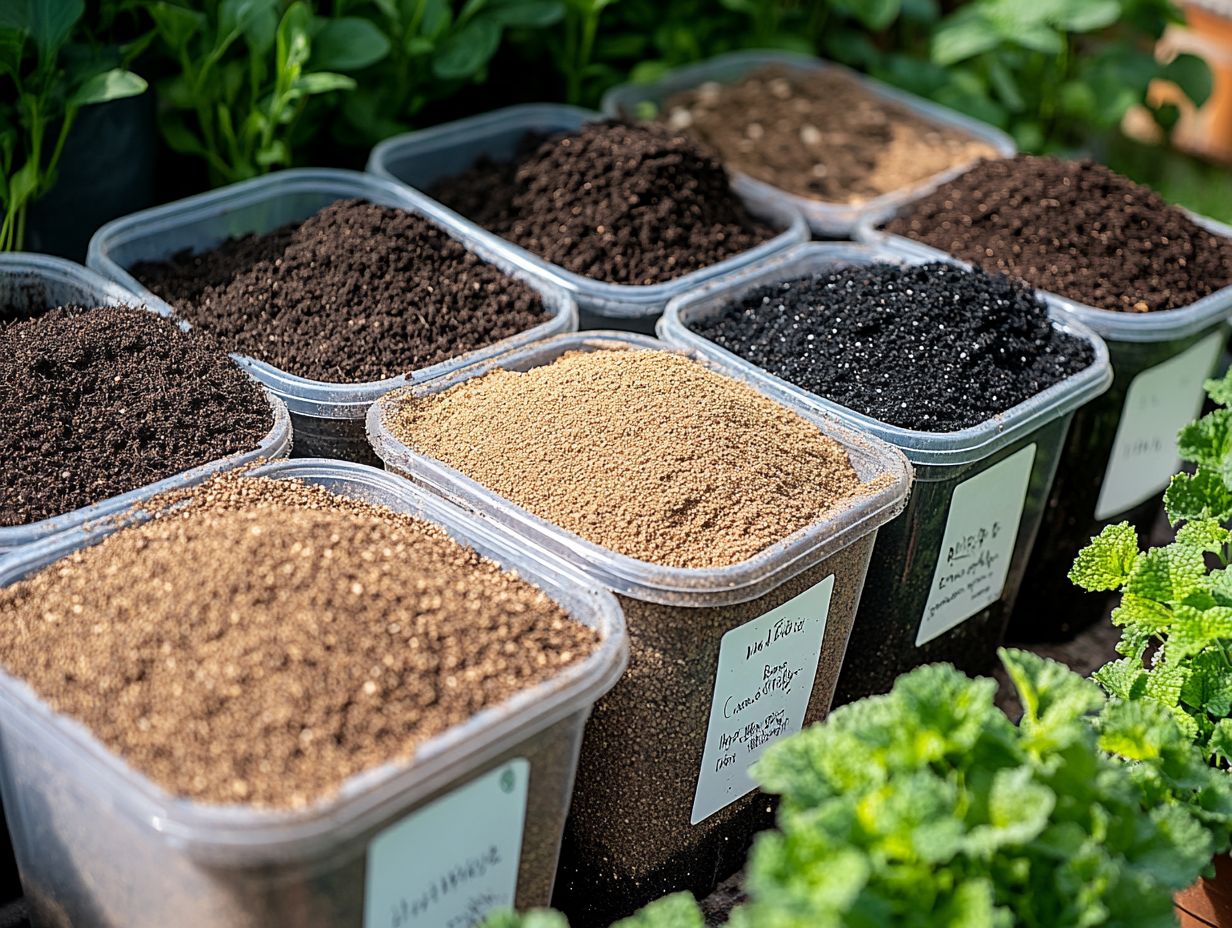
Soilless potting mix creates the perfect growing environment without traditional soil. It emphasizes moisture retention and air circulation essential for the health of your container plants and hydroponic systems.
This innovative blend usually includes key ingredients like coconut coir, which retains moisture while ensuring excellent drainage. Perlite enhances aeration and prevents soil compaction, promoting robust root health. Vermiculite, another lightweight mineral, retains moisture and nutrients, releasing them gradually to nourish your plants.
Using soilless mixes helps tackle common soil-related issues like poor drainage and pests, making it an exceptional choice for indoor gardening, balcony planters, and hydroponic setups.
15. Homemade Potting Soil Recipes
Homemade potting soil recipes offer you a cost-effective and customizable solution tailored to meet the specific needs of your plants. By incorporating a range of soil amendments and organic materials, you can create the perfect environment for optimal growth.
When you tailor these mixes, you can enhance drainage and moisture retention, ensuring that each plant thrives according to its unique requirements. For instance, adding peat moss can significantly improve moisture retention. Meanwhile, perlite or vermiculite boosts aeration, promoting robust root health.
Including compost not only enriches the soil with essential nutrients but also introduces beneficial microorganisms, fostering a balanced ecosystem. This hands-on approach supports nutrient cycling and allows you to make adjustments based on seasonal changes or specific plant needs. Crafting your own potting soil is a fun and eco-friendly choice that every gardener will love!
What Factors Should Be Considered When Choosing Potting Soil?
When selecting potting soil, there are several essential factors to consider for optimal growth conditions for your plants. This includes understanding the various soil types available, how well they hold water, and their nutrient-holding properties tailored to each plant’s unique requirements.
Grasping the distinct characteristics of different soil types can profoundly influence your gardening experience. For example, sandy soils excel in drainage, making them perfect for plants that prefer drier conditions. On the other hand, clay soils, known for their superior water retention, cater beautifully to moisture-loving varieties.
Loamy soils, which combine sand, silt, and clay, strike a balance that supports a diverse range of plants. It s also vital for you to maintain the right moisture level and nutrient balance. Doing so not only encourages vigorous growth but also boosts your plants resilience against pests and diseases. By matching the right soil type with the specific needs of your plants, you can cultivate thriving, lush environments that flourish beautifully.
How Can Different Types of Potting Soil Benefit Different Types of Plants?
Different types of potting soil offer unique benefits tailored to your specific plant growth requirements, enhancing overall health and performance in various gardening scenarios.
For instance, if you’re nurturing succulents, you’ll find they thrive in well-draining soil mixes typically composed of sand, perlite, and peat. These ingredients effectively prevent water retention and root rot.
On the other hand, if you re cultivating tropical plants like ferns and peace lilies, they ll favor a moisture-retentive mix rich in organic matter to maintain that crucial humidity. The drainage capacity of your potting soil can significantly impact your plants’ health. Using overly compact soil for a cactus could lead to devastatingly soggy roots.
Nutrient content is essential; a balanced mix for vegetables might require added fertilizers to support their rapid growth. This underscores the importance of selecting specific soil blends that cater to the diverse needs of your plants.
What Are the Key Ingredients in Potting Soil?
The key ingredients in potting soil are a carefully curated blend of organic and inorganic materials, paired with essential fertilizers that together create an ideal growing environment for your plants.
Among these components, peat moss is a standout. This vital organic material excels at retaining moisture while adding a touch of acidity that many plants simply love. You ll also find perlite in the mix; this lightweight volcanic glass enhances aeration and drainage, ensuring that your plant roots get the oxygen they need without the risk of becoming waterlogged.
Then there’s vermiculite, another inorganic addition that helps with moisture retention and nutrient holding capacity. This combination fosters a more dynamic environment for root development. A well-balanced potting mix usually features a healthy ratio of these organic and inorganic elements, each playing a crucial role in supporting the health and vitality of your plants.
Ready to create your own potting soil? Let s explore the ingredients you ll need!
Creating a Custom Potting Mix
Discover how you can easily create your own customized potting mix! Tailoring the ingredients specifically to your plants’ needs enhances their growth and vitality. By selecting organic materials and soil amendments carefully, you can make a mixture that truly supports your plants.
This hands-on approach ensures optimal drainage and aeration while providing essential nutrients that various plant species require. Understanding each type of plant s specific needs allows you to craft a blend that promotes robust root development and overall health.
For instance, if you’re working with succulents, they thrive in a well-draining mix typically made up of:
- 50% potting soil
- 25% perlite
- 25% coarse sand
On the other hand, tropical plants may prefer a richer composition that incorporates compost, peat moss, and vermiculite. Experimenting with different ratios and ingredients can lead to even greater success in cultivating vibrant, flourishing plants in any environment. Start experimenting today!
What Are the Pros and Cons of Using Organic vs. Non-Organic Potting Soil?
The choice between organic and non-organic potting soil requires weighing sustainable practices against the immediate effectiveness of artificial plant food. Both play a crucial role in plant growth and health.
Opting for organic potting soil promotes better soil health by encouraging beneficial microbial activity. It enhances water retention and nutrient cycling over time, creating a thriving ecosystem for your plants. This gives them the power to grow stronger and more resilient.
In contrast, non-organic options often deliver quick nutrient availability, which can be tempting if you’re seeking immediate results, especially in fast-paced gardening situations. However, this short-term boost comes with risks, such as loss of nutrients and potential environmental damage.
While non-organic soil might seem budget-friendly and promise rapid growth, organic potting soil offers enduring benefits for both your plants and the planet.
Frequently Asked Questions
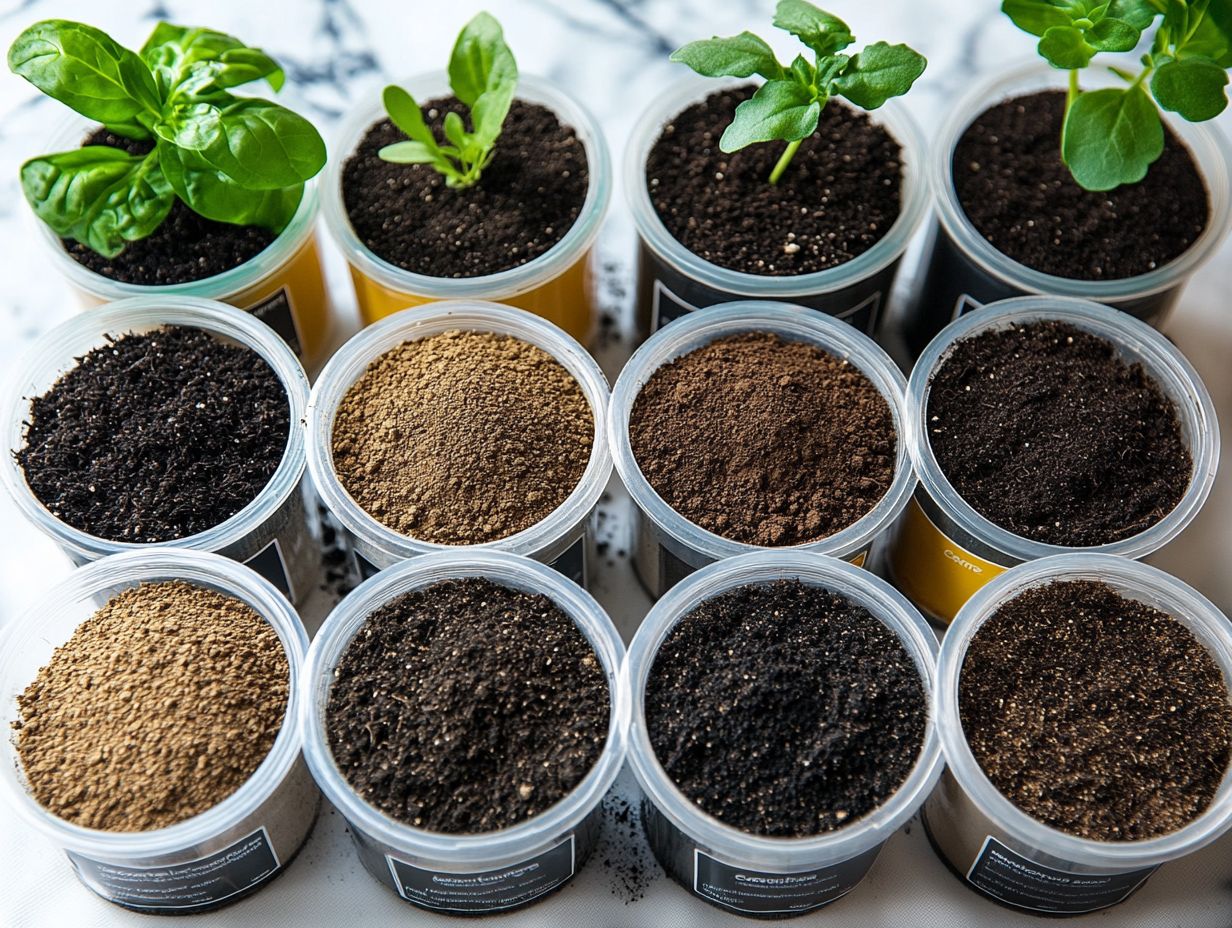
What are the most common types of potting soil?
Common types of potting soil include peat-based, compost-based, and perlite-based options. Each type has different properties and is suitable for various plants.
What is peat-based potting soil?
Peat-based potting soil is primarily made from decomposed sphagnum moss. It’s known for its high water-holding capacity and good aeration, making it ideal for plants that prefer moist conditions, such as ferns and tropical plants.
How is compost-based potting soil different?
Compost-based potting soil consists of a mixture of organic materials, including compost, bark, and coconut coir. It is rich in nutrients and suitable for a wide range of plants, including vegetables and annuals.
What is perlite-based potting soil?
Perlite-based potting soil contains small, lightweight particles of volcanic glass that provide excellent drainage and aeration. It is often used for succulents and other plants that prefer dry conditions.
Can I create my own potting soil?
Yes! You can create your own potting soil by mixing various types of organic materials, such as compost, peat moss, and perlite. Research the needs of your plants to create a suitable blend for their specific requirements.
Do different types of potting soil need to be changed regularly?
Potting soil should be changed every 1-2 years as nutrients can become depleted and the soil can compact. However, if you have plants that prefer certain types of soil, like cacti or orchids, it may be best to leave that soil and simply add fresh nutrients on top.

